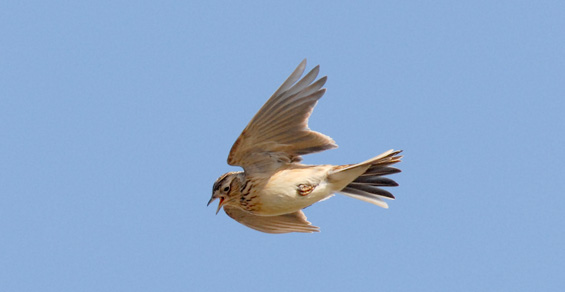
There is a piece of music that over the years has meant more to me than most. I first came across it in my early twenties and it led to a love of English music from around the early years of the twentieth century.

The Lark Ascending was written by Ralph Vaughan Williams in 1914 and inspired by George Meredith’s poem, The Skylark, it’s is a lengthy piece, some 122 lines, but paints a wonderful lyrical picture of the rising of the Skylark as it marks out its territory.
During the time Meredith was writing and even a little later when Vaughan Williams was composing, the Skylark was so common that they were netted in huge numbers, used for food and actually exported to Paris as a delicacy. It’s a little different nowadays but the Skylark has other concerns that threaten its survival. Changing farming methods have reduced numbers considerably over the last few decades and whilst there are areas where the decline has been arrested, the bird is still on the Red conservation list and in trouble. The aptly named Hope Farm, that was purchased by the RSPB back in 1999, has been used as a study area to try and understand how contemporary farming and the Skylark can exist side by side.

Back in my early bird watching years I remember walks on the Lancashire coast in the spring when the Skylark was rising from the dunes seemingly every few metres. On sunny mornings the sound was nothing short of spectacular as countless birds rose to heights of over 1000 feet belting out for all they were worth. I was reminded of these times at Sker over the weekend when I came across a group of around six birds, all very active in the warmth of the morning sun. I stayed with them for an hour or so marveling at their territorial displays and thinking that we can’t afford to loose any more of these stunning songsters.

The Lark Ascending captures the essence of these moments and is like bringing the bird in to your living room – far better than our ancestors who would literally do this by caging the Skylark in the hope it would continue to sing, but a caged bird knows better. It seems we’ve moved on in some aspects of our attitudes to birds but by no means in all. Unless we are prepared to take on board the research carried out at places like Hope future generations will only have Vaughan Williams and George Meredith to conjure up the spirit of the Skylark.

Technical Information:
Skylarks in Flight:Â ISO 400 – 1/2500 sec. – f 9 – 500mm + 1.4 converter
Skylark on Bracken:Â ISO 400 – 1/2000 sec. – f 8 – 500mm + 1.4 converter
Skylark on Post:Â ISO 250 – 1/500 sec. – f 8 – 500mm + 1.4 converter
